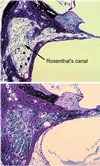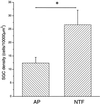Neurotrophic factor intervention restores auditory function in deafened animals
- PMID: 11818566
- PMCID: PMC122246
- DOI: 10.1073/pnas.032677999
Neurotrophic factor intervention restores auditory function in deafened animals
Abstract
A primary cause of deafness is damage of receptor cells in the inner ear. Clinically, it has been demonstrated that effective functionality can be provided by electrical stimulation of the auditory nerve, thus bypassing damaged receptor cells. However, subsequent to sensory cell loss there is a secondary degeneration of the afferent nerve fibers, resulting in reduced effectiveness of such cochlear prostheses. The effects of neurotrophic factors were tested in a guinea pig cochlear prosthesis model. After chemical deafening to mimic the clinical situation, the neurotrophic factors brain-derived neurotrophic factor and an analogue of ciliary neurotrophic factor were infused directly into the cochlea of the inner ear for 26 days by using an osmotic pump system. An electrode introduced into the cochlea was used to elicit auditory responses just as in patients implanted with cochlear prostheses. Intervention with brain-derived neurotrophic factor and the ciliary neurotrophic factor analogue not only increased the survival of auditory spiral ganglion neurons, but significantly enhanced the functional responsiveness of the auditory system as measured by using electrically evoked auditory brainstem responses. This demonstration that neurotrophin intervention enhances threshold sensitivity within the auditory system will have great clinical importance for the treatment of deaf patients with cochlear prostheses. The findings have direct implications for the enhancement of responsiveness in deafferented peripheral nerves.
Figures



References
-
- Skinner M W, Clark G M, Whitford L A, Seligman P M, Staller S J, Shipp D B, Shallop J K, Evringham C, Menapace C M, Arndt P L, et al. Am J Otol. 1994;15 Suppl. 2:15–27. - PubMed
-
- Kiefer J, Muller J, Pfenningdorff T, Schön F, Helms J, von Illberg C, Baumgartner W, Gstöttner W, Ehrenberger J, Arnold W, et al. ORL Otorhinolaryngol Relat Spec. 1996;58:127–135. - PubMed
-
- Illg A, von der Haar-Heise S, Goldring J E, Lesinski-Schiedat A, Battmer R D, Lenarz T. Ann Otol Rhinol Laryngol, Suppl. 1999;177:93–98. - PubMed
-
- Nadol J J, Young Y S, Glynn R J. Ann Otol Rhinol Laryngol. 1989;98:411–416. - PubMed
-
- Gantz B J, Woodworth G G, Knutson J F, Abbas P J, Tyler R S. Ann Otol Rhinol Laryngol. 1993;102:909–916. - PubMed
Publication types
MeSH terms
Substances
Grants and funding
LinkOut - more resources
Full Text Sources
Other Literature Sources
Medical

